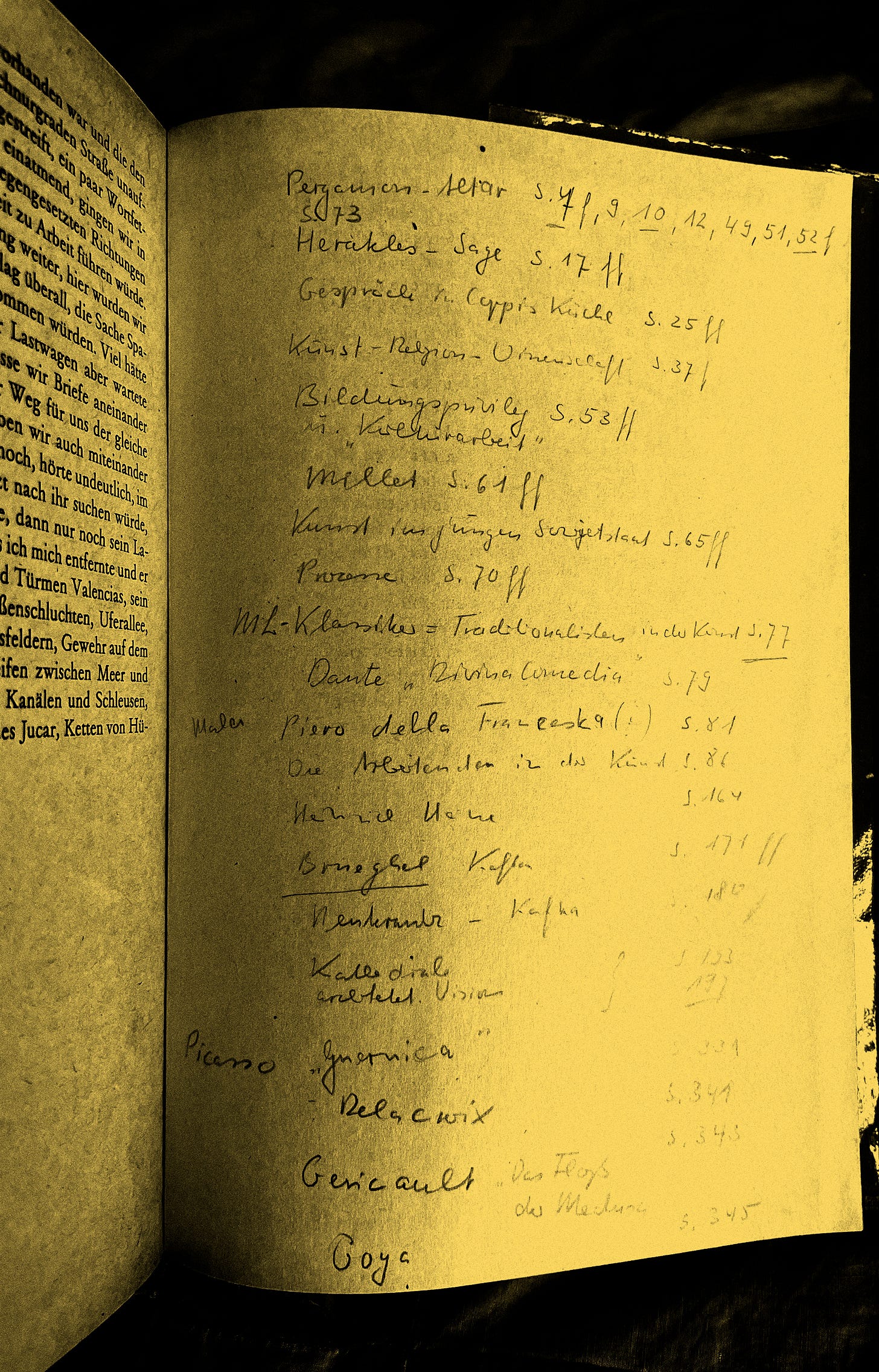This week, in lieu of a full post, a quick programming note: next Tuesday, March 25, marks the release of the third and final volume of the first-ever English language edition of Peter Weiss’s novel The Aesthetics of Resistance, published by Duke University Press in a translation by Joel Scott. It is a transformative book, a work in which I’ve been profoundly immersed for the last six months, and one that I can’t stop thinking and talking and writing about. Its appearance in a completed translation is cause for celebration and, as an unavoidable knock-on effect, a whole bunch of posts from me.
Prior to last fall, The Aesthetics of Resistance--which traces the lives and ideas of a generation of participants in the antifascist resistance from 1937 to 1945--was a book I’d heard of and read about a bit, though all I’d experienced of Peter Weiss’s work firsthand was Marat/Sade and its very sick 1967 film adaptation. I was aware, though, that Aesthetics was super long, very legit politically, and an extremely difficult read, so I was equal parts psyched and scared to get to it eventually. When Bela set the book up as the subject of a Workshops for Gaza reading group, it was the perfect opportunity (thank you Bela). I made my way through vols 1 and 2 over the fall and early winter, and the books were so good, and wrecked my shit to such an incredible extent, that I got hold of an advance copy of volume 3, which I read and marked up last month to the tune of like five cashed highlighters. Now I’ve ordered and am trying to read the 1983 East German edition, but that’s an expression of my own madness more than anything else.
Anyway, I’ve done some more extensive writing on the book that will appear soon, but for now, I’ll just say that if you are interested in the history of the international left, the long arm of the reformism vs. revolution debate, or in Benjaminian reinterpretations of entire canons of art, then sure, consider this new edition of The Aesthetics of Resistance a “pick to click.” But more broadly: if you’re a person without a deep stake in these debates but you still find this present era of crisis to be, maybe, a little bit of a bummer, know that this book offers something invaluable. In its blow-by-blow accounting of both a ruinous political moment and of the liberatory possibility inherent in that moment’s midst, The Aesthetics of Resistance is an experience of real sustenance. Coming at a time when that sort of thing is in piteously short supply, it’s a read that is well worth the trouble.
If you’re in New York, there are events this week at the CUNY Graduate Center and The Poetry Project at St. Mark’s (the latter event, tomorrow night, will also stream live). I will be there, psyched as hell.
Liebe Grüße--
Mark
Detail of the Eastern Frieze of the Pergamon Altar, an artwork whose missing depiction of Heracles figures as a central metaphor in The Aesthetics of Resistance.
A handwritten endpage glossary in my secondhand copy of the German edition, an intergenerational echo of all the notating and highlighting I did on my English readthrough. I could have cried when I came upon this thing.
.·:''''''''''''''''''''''''''''''''''''''''''''''''''':·.
: : ________ ___ ___ ________ ________ : :
: : |\ ____\|\ \|\ \|\ __ \|\ ____\ : :
: : \ \ \___|\ \ \\\ \ \ \|\ /\ \ \___|_ : :
: : \ \_____ \ \ \\\ \ \ __ \ \_____ \ : :
: : \|____|\ \ \ \\\ \ \ \|\ \|____|\ \ : :
: : ____\_\ \ \_______\ \_______\____\_\ \ : :
: : |\_________\|_______|\|_______|\_________\ : :
: : \|_________| \|_________| : :
: : ________ ________ ___ ________ _______ : :
: : |\ ____\|\ __ \|\ \|\ __ \|\ ___ \ : :
: : \ \ \___|\ \ \|\ \ \ \ \ \|\ /\ \ __/| : :
: : \ \ \ \ \ _ _\ \ \ \ __ \ \ \_|/__ : :
: : \ \ \____\ \ \\ \\ \ \ \ \|\ \ \ \_|\ \ : :
: : \ \_______\ \__\\ _\\ \__\ \_______\ \_______\ : :
: : \|_______|\|__|\|__|\|__|\|_______|\|_______| : :
'·:...................................................:·'






